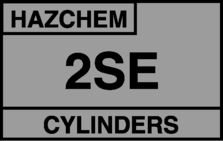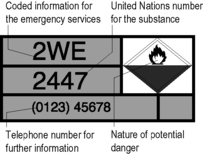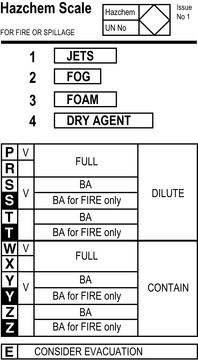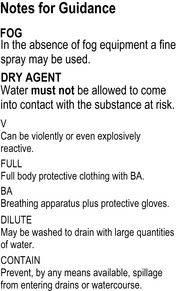Chapter 44. Chemical incidents
Chemical casualties may be generated from a wide range of incidents including explosions, fires, leaks, spills or through the ingestion of contaminated water. This can result in casualties suffering from a multitude of injuries including:
• Burns (thermal, chemical or both)
• Trauma
• Environmental effects (hypothermia)
• Acute poisoning
• Fire and explosion.
However, the direct effects of exposure to chemicals may result in:
• Acute or chronic poisoning from the absorption of the chemical through the lung, skin or digestive tract
• Direct tissue damage to the skin or lungs.
The severity of these injuries will depend on a number of factors including:
• The strength of the chemical
• The prevailing environmental conditions
• The length of time an individual is exposed to the chemical.
The first priority is to remove the casualty from the main area of chemical exposure (the hot zone) and then second, to decontaminate the casualty as quickly as possible.
Hazard warning symbols
The standard diamond-shaped hazard warning symbols indicate to both the emergency services and the public the primary hazard present. Symbols represent hazards including flammable solids or liquids, flammable or toxic gases, compressed gases, oxidising agents and corrosive substances. On multiloads, the hazard warning diamond simply contains an exclamation mark.
 |
| Figure 44.1. |
| Conventional hazard warning signage. |
 |
| Figure 44.2. |
| A HAZCHEM plate. |
The HAZCHEM action code system
The HAZCHEM code system is a set of code numbers and letters displayed on a vehicle carrying hazardous substances which gives information about the appropriate fire-fighting methods and personal protection needed to deal with a spill.
HAZCHEM also gives guidance as to whether or not the substance can be safely washed into drains and whether evacuation of surrounding areas should be considered.
The HAZCHEM plate displayed on vehicles will also show the diamond warning sign, the United Nations (UN) number for the chemical carried and a contact number for specialist advice from the manufacturer.
ADR Kemler code
The ADR system is the European road transport system of hazardous load markings. Vehicles must bear a 40 × 30 cm label on both front and rear. The label is in two parts: the upper bears the Kemler code and the lower the UN substance number.
 |
| Figure 44.3. |
| HAZCHEM code system aide-memoire card (front). |
 |
| Figure 44.4. |
| The HAZCHEM code system aide-memoire card (back). |
The Kemler code comprises two or three digits which indicate the properties of the load carried. The first digit describes the primary hazard and the second and third digits the secondary hazards. If the same number is repeated, this indicates an intensified hazard. An ‘X’ in front of the UN substance number indicates that it must not be brought into contact with water. There is no provision in the ADR system for any words to be placed on the warning plate.
Buy Membership for Emergency Medicine Category to continue reading. Learn more here




